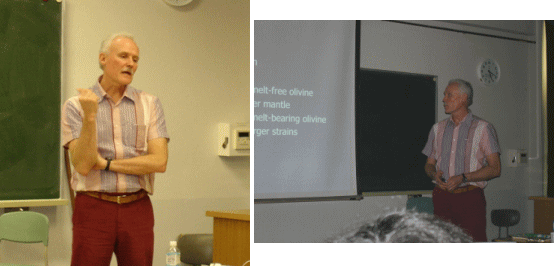13th GRC International Frontier Seminar
THE LABORATORY STUDY OF SEISMIC WAVE DISPERSION AND ATTENUATION IN UPPER-MANTLE MATERIALS: PROGRESS AND PROSPECTS
Prof. IAN JACKSON
Research School of Earth Sciences, Australian National University, Canberra, ACT, Australia

Novel techniques for torsional forced oscillation/microcreep measurements
under conditions of simultaneously high temperature and pressure have recently
been applied in a study of polycrystalline olivine (Mg1.8Fe0.2SiO4). Fine-grained specimens have been prepared with and without added basaltic glass
with melt fractions ranging from < 0.01 to 4%. Forced oscillation tests performed during slow staged cooling following annealing at 1200-1300℃ reveal
qualitatively different behaviour of the melt-free and melt-bearing specimens. For the melt-free specimens (< 0.01 % melt), the strain-energy
dissipation is of the ‘high-temperature background’ type-varying monotonically with period and temperature. Specimens containing as little as 0.01% melt
at high temperature exhibit a broad dissipation peak superimposed upon a melt-enhanced background. The peak height scales with melt fraction, and its breadth
implies a distribution of relaxation times about two decades wide. The peak moves to markedly shorter oscillation period with increasing temperature requiring
an activation energy of about 720 kJ/mol. The peak cannot plausibly be explained by stress-induced grain-scale redistribution of melt (‘melt squirt’). Instead,
it is attributed to elastically accommodated grain-boundary sliding apparently facilitated by the rounding of grain edges at triple-junction melt tubules.
Elastically accommodated sliding is evidently suppressed in the melt-free materials by the presence of tight (~ nm) grain-edge intersections. In both classes
of material the background dissipation and associated modulus dispersion are attributed to diffusionally accommodated grain-boundary sliding.
The observed viscoelastic behaviour is best parameterised with a Burgers-type
creep function. This approach provides an internally consistent description
of the variations of both the shear modulus G and the strain-energy dissipation
1/Q with frequency, temperature, grain size and potentially, melt fraction.
Such models provide a robust framework for application of the insights
gained in the laboratory to teleseismic wave propagation in the Earth’s
mantle. Our model for the behaviour of melt-free olivine has recently been
used to assess variations of shear-wave speed and attenuation in the upper
mantle. Away from mid-ocean ridges and subduction zones, the first-order
features of representative wave speed (and attenuation) versus depth models
for both oceanic and continental upper mantle can be explained by sub-solidus
temperature variations, without recourse to widespread partial melting
and/or compositional variations. In ongoing work we are seeking to identify
other factors with a potentially important influence on upper-mantle seismic-wave
dispersion and attenuation-particularly the presence of dislocations
reflecting prior deformation by dislocation creep and trace amounts of
water. Progress in parallel experiments on synthetic olivine polycrystals
and natural peridotites will be described.
お問い合わせ先: irifune@dpc.ehime-u.ac.jp TEL 089-927-9645
詳細情報:http://www.ehime-u.ac.jp/~grc/
主催:愛媛大学地球深部ダイナミクス研究センター